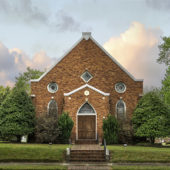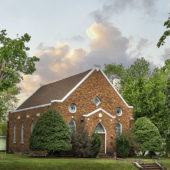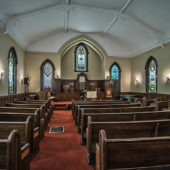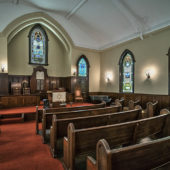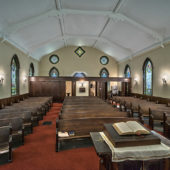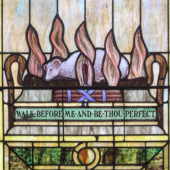The oldest synagogue building in Tennessee and one of fewer than a hundred surviving 19th century synagogues in the country.
Written in 1967 by Mrs. Helen Sternberger, whose descendants still live in Brownsville and lovingly care for the synagogue:
HISTORY OF THE TEMPLE
The history of Congregation Adas Israel and its Temple may well be that of any group of people in a small community, who considered their activities as unimportant, of no real significance. Hence they kept no records. It is only with the advent of the second or third generations that these seemingly mediocre happenings assume real proportions, and viewed in the proper perspective become the history of a congregation, a link, so to speak, closely joining the activities of one generation to the succeeding one.
With no records kept, and this may well be said of the present era, events and matters of interest have been handed down by word of mouth. It is a tale of remembrance. One must be mindful, too, that sentiment played its part in the memory of the narrator.
It 1s a narrative of families closely related to one another, both by birth and by intermarriage. It is a tale of religious togetherness, meant to keep alive tho flame of Judaism, not only for themselves, but for their children, and for the generations yet unborn. It is a tale of men and women, newly arrived in a strange country, which they had chosen to be their home. Among unfamiliar surroundings and customs, but in a land of freedom — freedom most of all to worship as they chose, the thoughts uppermost in their hearts and minds were how they could establish themselves securely and religiously, and provide for the survival of their faith.
Of such ideals was the foundation of this congregation, which had its roots in the mid 1800’s.
In the early 1860’s, Joe Sternberger and his brother Sol came to America from Germany. Joe eventually found himself in Brownsville. He brought with him a Torah, a parting gift from his father, who, no doubt prayerfully hoped that this precious possession might someday be the incentive for the establishment of a religious group in that far away land. The prayers of the father were answered, for as if by some miracle, the Torah, the nucleus for worship was brought to the Jewish community of Brownsville, which, too, felt its prayers had been answered.
Immediately, Jacob and Karoline Felsenthal, who already lived here, set aside a room in their home to house the Torah and to serve as a place where services could be held.
My grandfather, Isaac Levi, was the first lay reader.
In 1867, Congregation Adas Israel came into being.
In 1869, Isaac Levi died. His remains are interred in our cemetery here.
In this same year, Emil Tamm came to Brownsville. In Germany he had studied for the rabbinate, but like so many young men yearned to see the land beyond the western horizon and taste of its freedoms.
Emil Tamm became the new lay reader in 1869 and served the congregation continuously until his death in 1907. During these years, Sabbath school was organized and many of the boys, as they reached the age of 13, under his tutelage, accepted their Jewish responsibilities in Bar Mitzvah services. There also were confirmands.
With the passing years, the Anker family and the Rothschild family in turn, provided sanctuary for the Torah, and a special place for worship, sometimes upstairs over their places of business.
During these years, the number of Jewish families was possibly at its peak. Many of them had from eight to ten children, and the need for a real house of worship manifested itself.
So in 1882, the congregation erected a Temple. It was only a wooden structure, but the Torah had at last found its rightful place in the ark. There it rests today. Dedicatory services were conducted by Rabbi Max Samfield of Memphis. An organ was installed in the choir loft at the rear of the Temple. During the ensuing years, the talented Jewish young people provided the music.
In 1909, Abe Sternberger and his family moved to Brownsville from Memphis. His parents, the Joe Sternbergers Sr. prevailed on him to read the services. This he did until 1931 when he again moved to Memphis. During his years as lay reader Sabbath School was again organized and the Bar Mitzvah service held.
It was in the very early 1920’s that the Temple was brick veneered. The original form of the building was retained.
The interior underwent many changes. The rostrum was enlarged, a new organ purchased and placed thereon and new pews were installed. Space at the rear of the building served as Sabbath school rooms. The ark and the lectern were not changed. Only the wood was polished to bring out its rich patina.
Gifts of memorial windows enhanced both the interior and exterior beauty of the edifice. Other memorial gifts were a new perpetual lamp, the menorahs and some of the other lighting fixtures. The tablets of stone, representing the Ten Commandments, placed above the doors of the ark were given in compliment to living parents. In later years, the silver urns, the chairs on the rostrum and more recently new doors to the ark, were all memorial gifts.
In 1922, the congregation joined the Union of American Hebrew Congregations.
In 1936, Morton Felsenthal became our lay reader and is serving in that capacity now.
As has already been noted in the beginning, the Jewish community was small in number. In the late nineteenth century and the early twentieth century it probably reached its numerical peak. Today we are again small in number, but we cling tenaciously to our faith and to our Temple in which we take great pride.
Our house of worship has been the scene of much happiness and equally much sorrow. Innumerable weddings have taken place within its walls. Before the advent of the public funeral home, last rites were often said in Temple, instead of the home of the deceased.
The future does not paint a bright picture for Temple Adas Israel, as a house of worship. Our young folks have sought their fortunes in the cities. Who is there to take our place?
There is a ray of hope, tho only a small one.
Industry is bringing many families to Brownsville. They are settling here. The population of the city is on the increase.
We hope to provide for the future maintenance of the Temple, not only to preserve the edifice, but in the hope that among the newcomers there may be families of our own faith, who will be pleased and grateful to find here a Temple in which to worship.
Fondly do we hope. Fervently do we pray.
Helen G. Sternberger
Brownsville, Tennessee
November 26, 1967

